Translate this page into:
Role of homoeopathy in psoriasis – An evidence-based case series
*Corresponding author: Dr. Annapurna Yemmanuru, The Homoeopathic Studio, Navodaya Colony, Yella Reddy Guda, Hyderabad, Telangana, India. thehomoeopathicstudio@gmail.com
-
Received: ,
Accepted: ,
How to cite this article: Yemmanuru A. Role of homoeopathy in psoriasis – An evidence-based case series. J Intgr Stand Homoeopathy. 2024;7:46-59. doi: 10.25259/JISH_38_2023
Abstract
The aim of the study was to evaluate the efficacy of Homoeopathic medicines in psoriasis patients. 6 patients suffering from psoriasis were considered. In each case, a detailed history, analysis and evaluation was done. The presenting symptoms and their modalities helped in forming the acute totality of the case. Understanding the probable causative factor, the mental state, the skin modalities, the past and the family history for the miasmatic background, the general thermal reaction helped in forming the Constitutional and Intercurrent totality of the case. Intercurrent remedies, Constitutional remedies, Acute remedies, Mother tinctures were given depending on the case. Psoriasis Area Severity Index (PASI) score and Dermatology Life Quality Index (DLQI) score were used for recording the improvement in patients at the beginning of treatment and at the end of 2 years. We used MONARCH assessment criteria to evaluate the effectiveness of Homoeopathic medicines. It is observed that PASI score and DLQI score significantly improved in all 6 patients after Homoeopathic treatment. Homoeopathic palliative medicines can effectively control the acute skin flare ups, and curative medicines help prevent further skin flare ups, giving long term remission of symptoms and thereby improving the Quality of life. Patient- reported satisfaction levels with this approach of Homoeopathic treatment is very high. This study also shows that use of such integrated approach with more than one indicated remedy doesn’t cause any suppression or adverse consequences in psoriasis patients.
Keywords
Homoeopathy
Psoriasis
DLQI
PASI
INTRODUCTION
Psoriasis is a chronic systemic inflammatory disease with a profound burden on the physical health, emotional well-being and quality of life (QoL). As of now, it is an incurable disease and demands lifelong treatment. Despite the invention of current treatment choices of biologics and oral therapy, a high rate of dissatisfaction from treatment is prevalent globally.[1] Non-achievement of clear/almost clear skin, recurrence of symptoms, side effects of the medications and inefficacy of the medications to control the disease process are the important reasons which leave the patients dissatisfied.[2] This prevents the patient from further continuing the treatment. Poor adherence to treatment implies a greater risk of physical problems such as skin disfigurement, itching, pain, swelling, bleeding, cracking and psychosocial problems.
A very small number of cases of psoriasis have been reported to be treated with homoeopathy effectively with a significant improvement in the skin symptoms and control on the disease process as evidenced by improvement in Psoriasis Area Severity Index (PASI) score.[3-6] There is a lot of prevailing dissatisfaction amongst patients and, thereby discontinuity in treatment due to delayed response to treatment. Every science needs to experiment. Hahnemannian Homoeopathy is the gold standard.[7] However, just like the Banerjee Protocol for managing cancers, this is an experimental approach.[8] The paper demonstrates using this approach in achieving the treatment goals[9] in psoriasis as evidenced by an improvement in PASI score and DLQI score at the end of 2 years through a series of 6 cases. MONARCH criteria for assessing the likelihood of a causal relationship between homoeopathic intervention and clinical outcome is applied. [10]
CASE SERIES
Case 1
Case history
A 17-year-old female came with psoriasis of 7 months duration for homoeopathic treatment in 2021. She had sought allopathic treatment for cracks in the heels a year back which had brought good relief. She also had a stressful event in her life, wherein a boy had proposed to her and she got scared. She feared sharing it with any of her family members. Later, she started with scaly blackish indurated patches on bilateral legs beginning from ankles, involving feet, legs and thighs. She has intense itching with subsequent scratching and bleeding from the lesions. She had occasional mild headaches. She craved salt. She would profusely sweat on her nose and head. She is generally reserved. She does not like consolation. There was a history of diabetes mellitus and death due to chronic renal failure in her family. Her base PASI score was 7.2 and DLQI score of 6.
Homoeopathic intervention
| Date | Symptoms | Prescription |
| 10.1.2021 | Skin severe itching<Cold water washing <Winter <Night >Warmth >Summer Reserved, sensitive to reprimands, Consolation aggravation, craving |
Arsenicum album 30 OD for 15 days Natrum muriaticum 200 OD once a week for 1 month |
| Date | Symptoms | Prescription |
| salt, sweat on nose and head H/o suppressed skin disease Great thickening of epidermoid layer and exfoliation of scales |
Sulphur 200 One dose stat Hydrocotyle Q 5 drops in half cup water BD daily for 1 month |
|
| 15.2.2021 | No scaling No itching |
Natrum muriaticum 200 OD once a week for 1 month Hydrocotyle Q 5 drops in half cup water BD daily for 1 month |
| 10.2.2022 | Itching started a few days back after 1 year | Sulphur 200 One dose stat Natrum muriaticum 200 OD once a week for 1 month |
| 14.4.2023 | Normal skin. | No intervention |
Outcome
At the end of 2 years, PASI is 0, DLQI is 0.
Case 2
Case history
A 24-year-old male came with psoriasis of 6 months duration for homoeopathic treatment in 2019. This person was in a relationship with a girl 2 years ago and wished to get married. His family did not support him. This event had a disturbing impact on him due to which he remained aloof from the family and used to weep a lot. Sadness was evident in his body language and speech during the interview. Later, he developed reddish coin shaped itchy psoriatic lesions on the beard, scalp and back, later involving bilateral hands and legs. He is generally a reserved person and has a friend with whom he usually opens up his mind. Tends to become irritated, but when confronted leaves that spot and goes away. He harbours the feeling that his skin looks very dirty. He craved meat and fish and was thermally chilly. He has a family history of diabetes mellitus and hypertension. His base PASI score was 17.2 and DLQI score was 21.
Homoeopathic intervention
| Date | Symptoms | Prescription |
| 8.3.2019 | Skin itching, inflammation <Cold | Arsenicum album 200 BD for 15 days |
| 23.3.2019 | Scaling, itching, dandruff on scalp psoriasis <Sun exposure A/F disappointment in love Reserved |
Sulphur 200 Single dose stat Natrum muriaticum 200 |
| Date | Symptoms | Prescription |
| 7.11.2020 | Skin <Sun exposure No skin lesions over the body except for a few stubborn lesions on the beard and scalp |
OD once a week for 1 month Sulphur 200 Single dose stat Natrum muriaticum 200 OD once a week for 1 month |
| 14.4.2023 | Asymptomatic | No intervention |
Outcome
At the end of 2 years, his PASI score was 0.2 and DLQI score was 0
Before Treatment: [Figures 1-3].
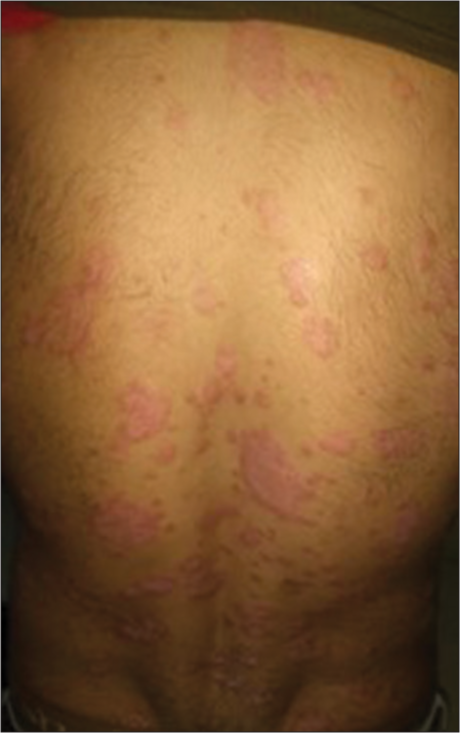
- Before treatment-case 2.
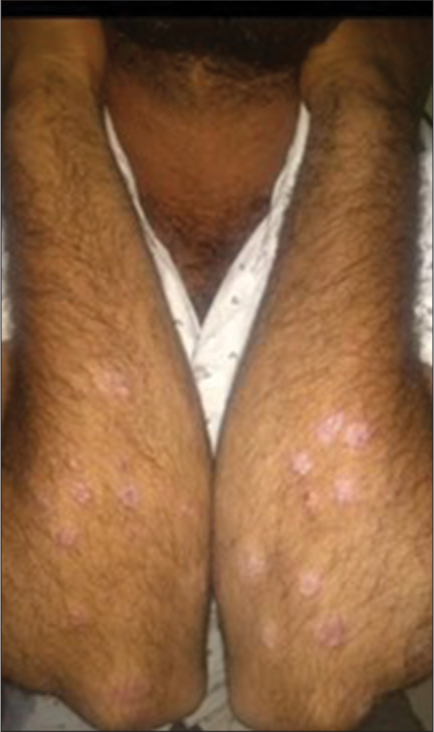
- Before treatmentcase 2

- Before treatment-case 2.
After Treatment: [Figures 4-6].
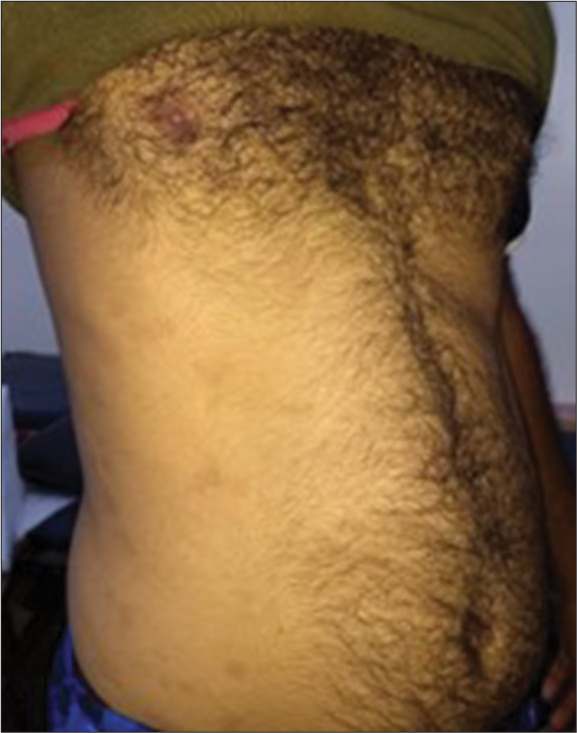
- After treatment-case 2.
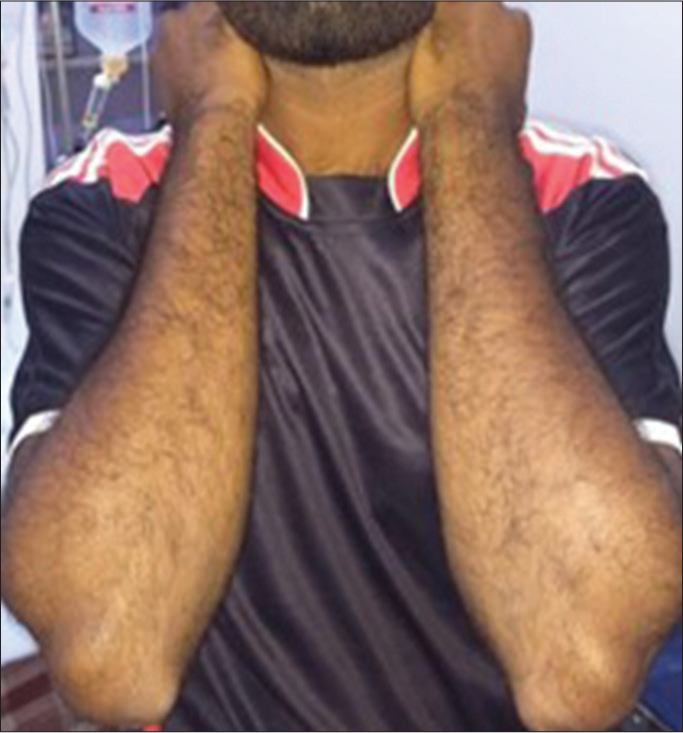
- After treatment-case 2.
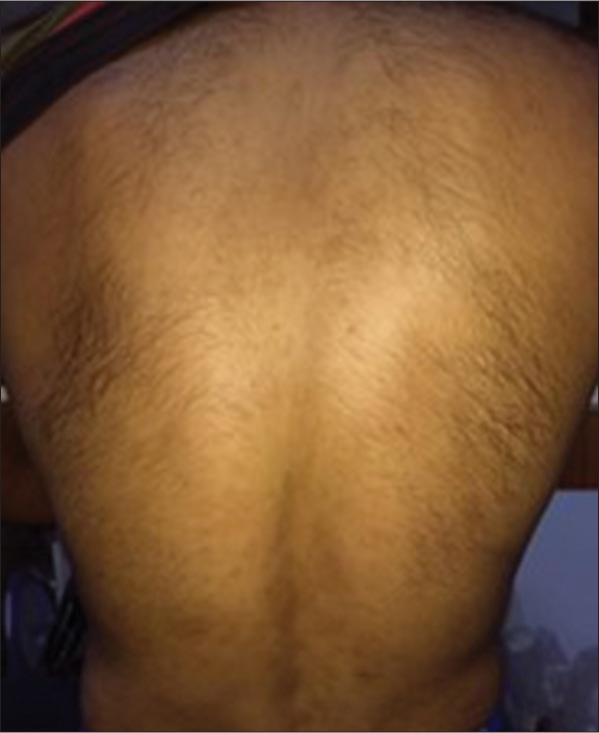
- After treatment-case 2.
Case 3
Case history
A 32-year-old female came with psoriasis of a 4–5 years duration for homoeopathic consultation in 2020. She revealed during the history that her 4 year old daughter suffered from epilepsy and died 4 years back. She still grieves for her child’s loss. Within 1 year of this loss, she developed cracks and blackish discoloration of skin with itching and severe scaling on bilateral soles and palms. Temperamentally, she is a reserved person and does not share her emotions with anyone. She is also very short tempered and irritable. She gets occasional bouts of headaches from these thoughts. She has a marked craving from salt and she is thermally hot. Her base PASI score was 6.4 and DLQI score was 14.
Homoeopathic intervention
| Date | Symptoms | Prescription |
|---|---|---|
| 15.8.2020 | Thermally hot Psoric Miasm Severe itching of skin with scaling <Night <Damp, cold weather >Warmth A/F Grief Thermally Hot Craving salt Headaches as a concomitant Severe powdery scaling of skin |
Sulphur 200 Single dose stat Arsenicum album 30 OD for 15 days Natrum muriaticum 200 OD once a week for 1 month Hydrocotyle Q 10 drops in half cup of water daily for 1 month |
| 20.9.2020 | Slight improvement | Arsenicum album 30 OD for 15 days Natrum muriaticum 200 OD once a week for 1 month Hydrocotyle Q 10 drops in half cup water daily for 1 month |
| 6.11.2020 |
Much better |
Arsenicum album 30 OD alternate day for 15 days Natrum muriaticum 200 OD once a week for 1 month Hydrocotyle Q 10 drops in half cup water daily for 1 month |
| 23.2.2021 | Asymptomatic except for slight brownish discoloration of skin | No intervention |
| 16.4.2023 | Mild brownish discoloration. No complaints | No intervention |
Outcome
At the end of 2 years, her PASI score was 0 and DLQI score was 0.
Before Treatment: [Figures 7-11].
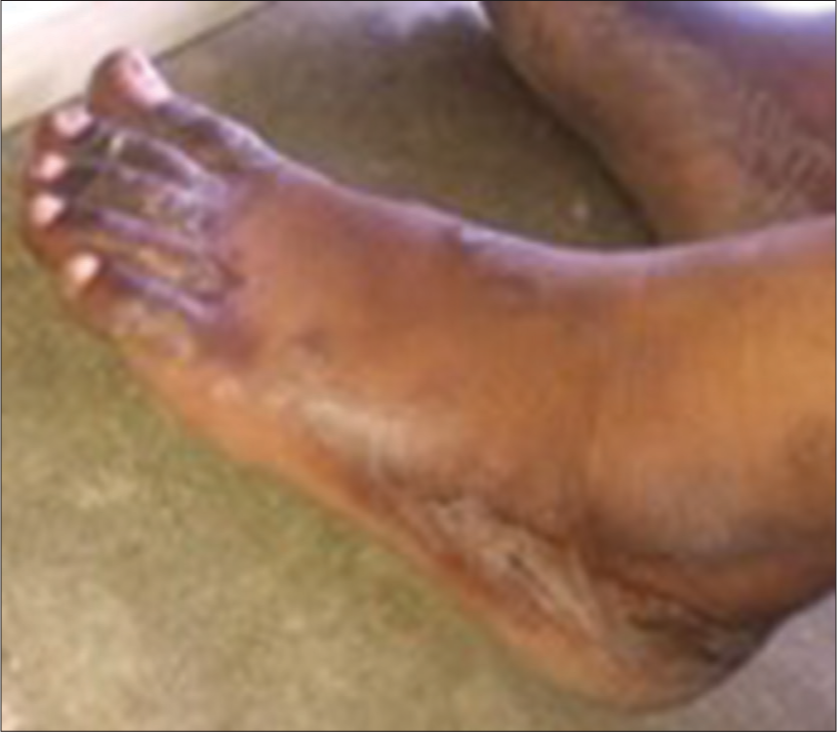
- Before treatment-case 3.
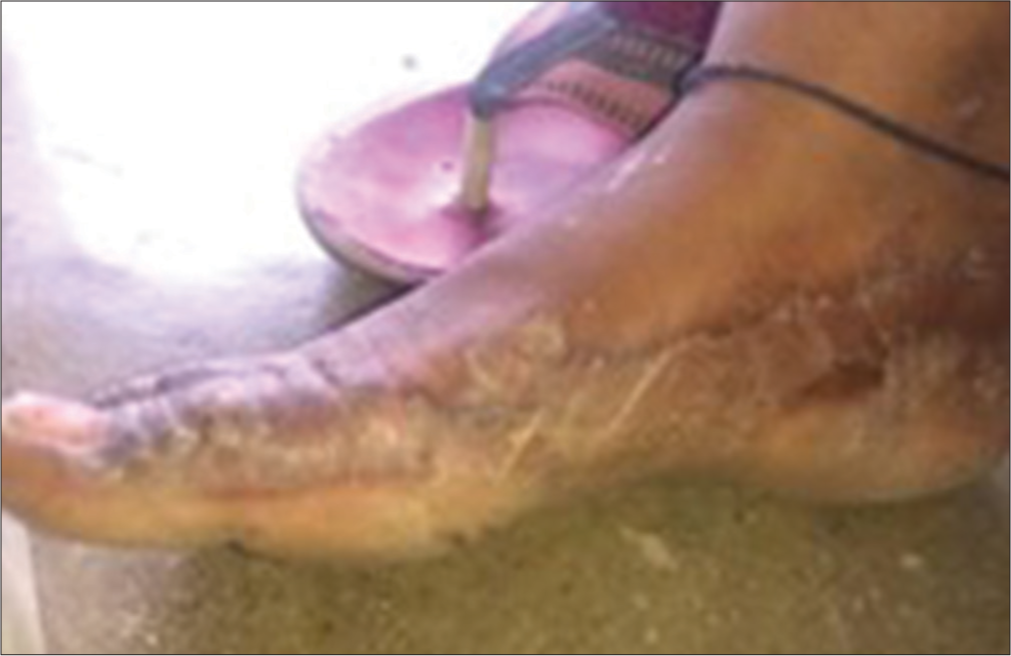
- Before treatment-case 3.
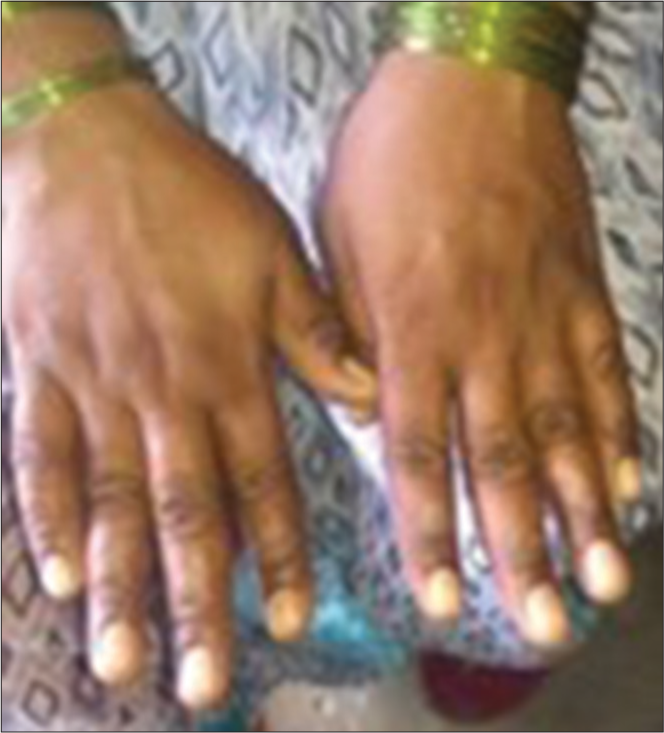
- Before treatment-case 3.
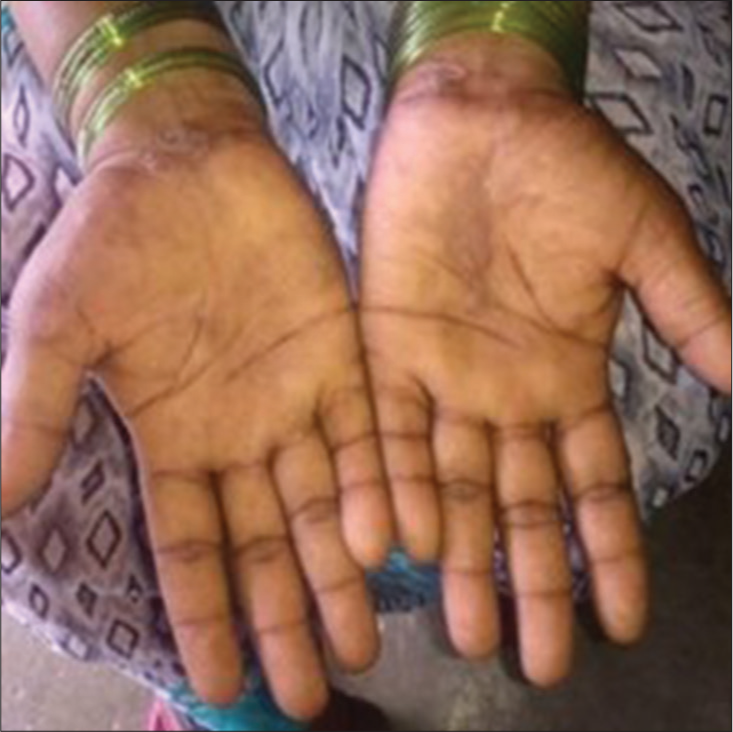
- Before treatment-case 3.
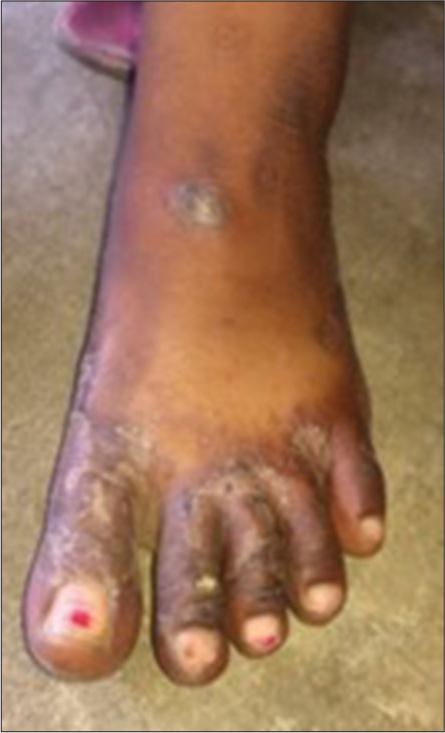
- Before treatmentcase 3.
After Treatment: [Figures 12-14].
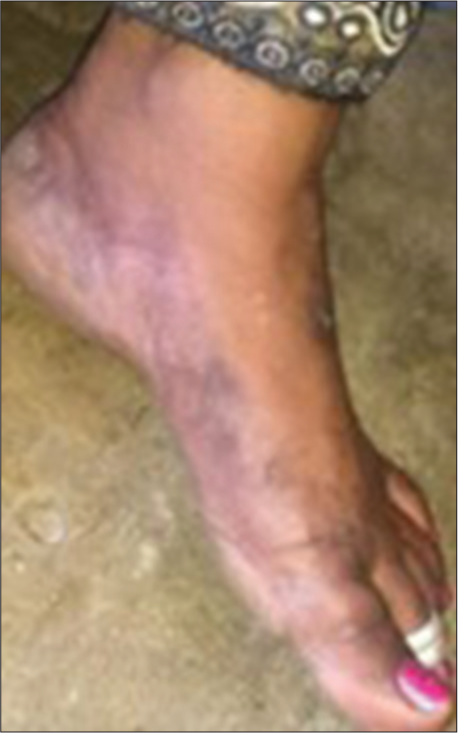
- After treatmentcase 3.
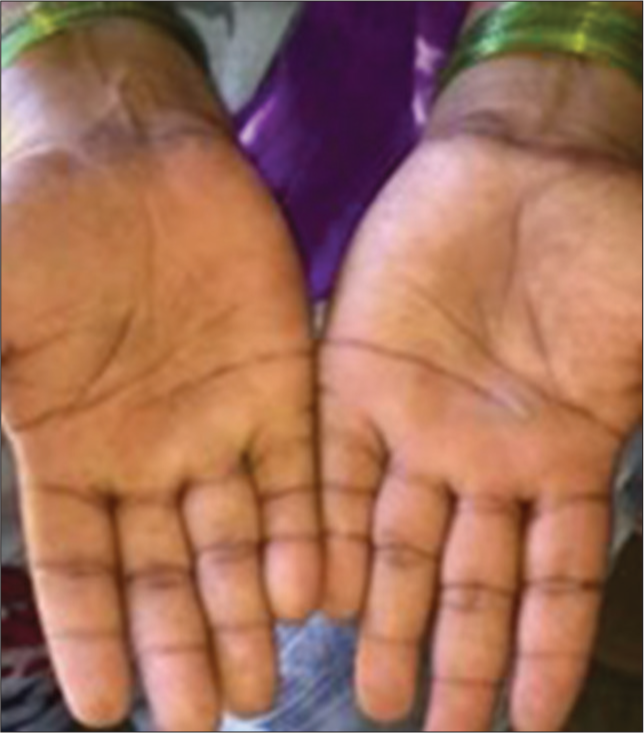
- After treatment-case 3.
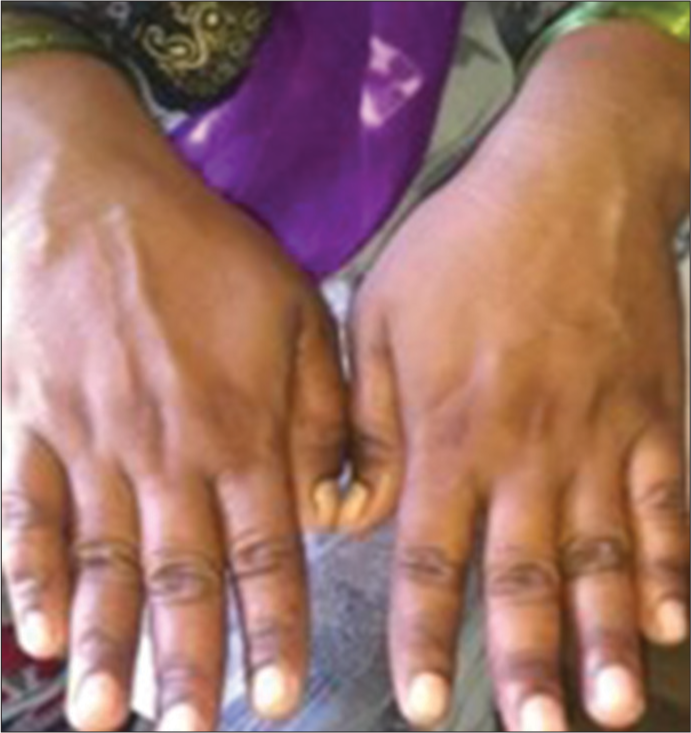
- After treatment-case 3.
Case 4
Case history
A 15-year-old girl came with psoriasis of 3 years duration for homoeopathic consultation in 2021. She had already taken a lot of conventional treatment for her complaints. She suffered some side effects due to which she stopped it and seeked homoeopathy. She had these complaints since childhood. She used to have stubborn dandruff. She also had 50 paise coin shaped, reddish lesions on her bilateral arms, elbows, face, abdomen and back. The lesions began on the left side and then spread to the right side. Now, she has had circular reddish patches on bilateral thighs for 2–3 years. There is scaling and itching which is worse in the evening and at night. Every 4–5 days, she had a tendency to have colds, coughs which lead to asthma. She was allergic to multiple things on the allergen report. She had a bowel movement on alternate days. She craved salt and disliked milk. She was thermally hot. Her menstrual cycles were delayed (45 to 60 days cycle). She was an introvert, reserved by nature and would get irritated on being consoled. Although living in a small town, her dressing style was very modern. She tended to weep at trifles. There was a family history of dust allergy. Her base PASI score was 23.5 and DLQI score was 23.
Homoeopathic intervention
| Date | Symptoms | Prescription |
|---|---|---|
| 12.1.2021 | Introvert Reserved Consolation <Skin <Summer Tendency to allergic colds |
Natrum muriaticum 200 One dose stat |
| 26.1.2021 | Skin lesions improving No episode of cold/asthma |
Natrum muriaticum 200 OD once a week for 1 month |
| 22.12.2021 | Skin lesions improved. No episode of cold/allergy | Natrum muriaticum 200 OD once a week for 1 month |
| 23.1.2022 | Mild skin flare up since a few days. Was asymptomatic till then. | Natrum muriaticum 200 OD once as week for 1 month |
| 16.4.2023 | No complaints, except for mild bouts of breathing issues due to inhalation of carpentry wood dust. Allergy frequency >No constipation. Menses regular |
No intervention |
At the end of 2 years, her PASI score 0 is and DLQI score is 0.
Before Treatment: [Figures 15-22].
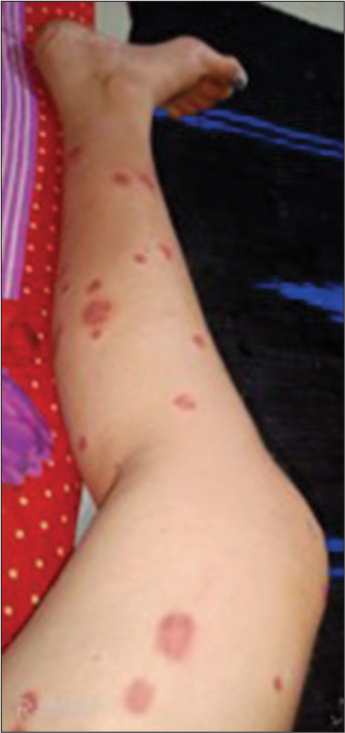
- Before treatment-case 4.

- Before treatment-case 4.
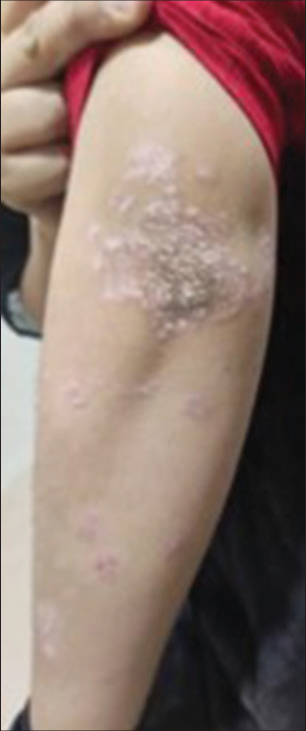
- Before treatment-case 4.

- Before treatment case 4.
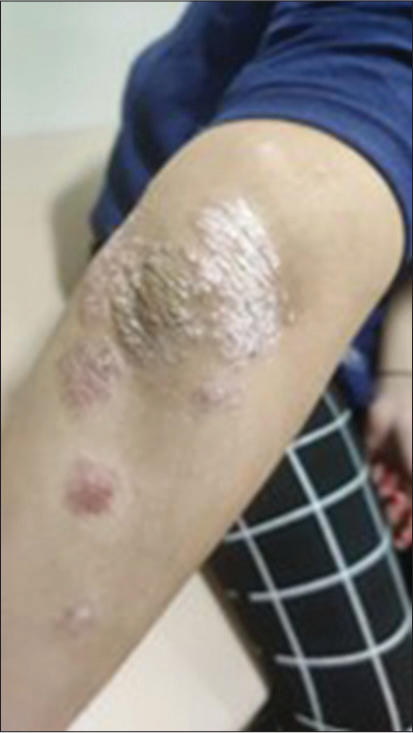
- Before treatment-case 4.
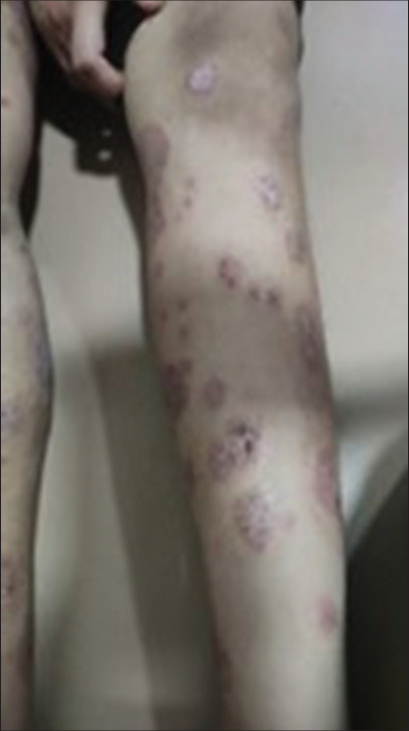
- Before treatment-case 4.

- After treatment case 4.
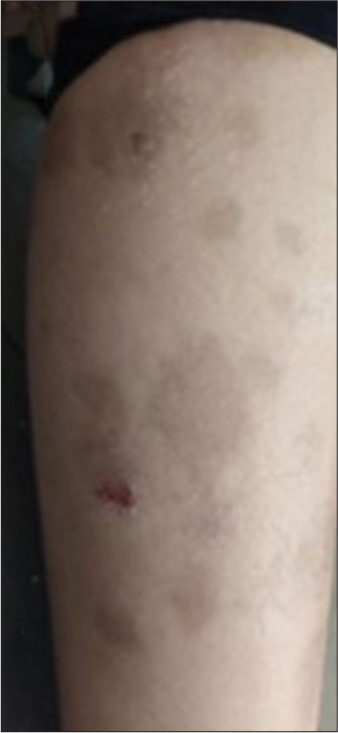
- After treatment-case 4.
After Treatment: [Figures 23 and 24].
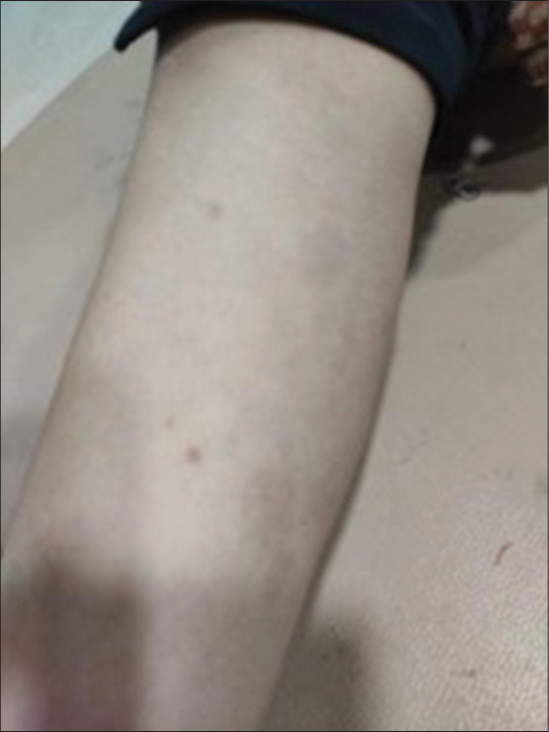
- After treatment-case 4.
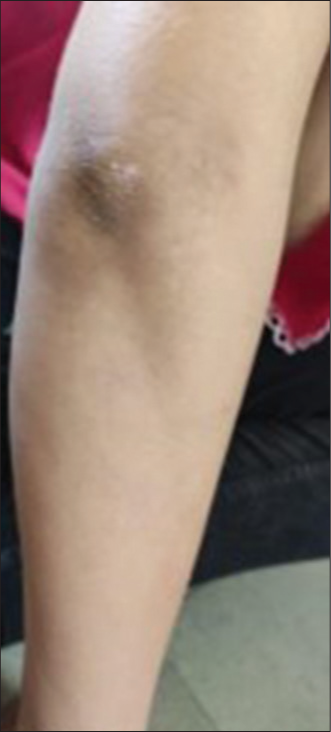
- After treatment-case 4.
Case 5
Presenting history
A 30-year-old male came with psoriasis of 2 years duration for homoeopathic consultation. He had already used allopathy and stopped due to the non-effectiveness of the treatment. He has been a marine engineer by profession since 2016. Stress at the workplace, financial stress and staying on ships for six months at a stretch were adding to the stress. That is when psoriasis started as a small patch on his scalp. He later left his job and eventually got married. The lesion remained status quo until his father’s death last year, when it started spreading from the scalp to the ear, then to the elbow and the knee for 1–2 months. Off late, even his nails were getting brittle. He has not taken any allopathic treatment for psoriasis for fear of having side effects. Along with psoriasis, he had dyspepsia from a variety of foods, egg allergy, anxiety and a very sensitive sleep. Temperamentally, he is a reserved, straightforward and anxious person. Whenever angry, he scolds and then calms down. He tries to divert himself. He is not able to forget his father’s death and keeps thinking about the same daily. He had many financial issues. Whenever he hears of any bad news, or reads any negative news, he gets anxious. He gets a fear as to what will happen to him. He will remain quiet and seclude himself. He will not talk to anyone at that time. With this anxiety, acidity increases. He is a very sensitive person. Whenever someone reprimands him, without any of his mistakes, he weeps. He left the marine job due to anxiety about his acidity as he felt that it may affect his heart.
Furthermore, he used to feel very lonely on the ship. He craves fish, prawns and chicken. He also craves sour food. Earlier, he used to suffer from constipation. He has a deviated nasal septum and suffers from colds once a year. He has a poor hunger tolerance. He gets headaches from hunger and gets better from eating. He is thermally hot. There is a family history of psoriasis, hypertension, diabetes mellitus and death due to cardiac arrest. His baseline PASI was 5.4, and his DLQI score was 16.
Homoeopathic intervention
| Date | Symptoms | Prescription |
|---|---|---|
| 31.10.2020 | <Sea <Grief Reserved Sensitive to reprimands Weeping from reprimands Cr- chicken, sour Hot Skin scaling |
Natrum muriaticum 30 OD weekly once for one month |
| Hydrocotyle Q 10 drops in half cup of water daily for one month |
||
| 28.11.2020 | Felt much better in acidity, anxiety, sleep and skin itching and scaling. |
Hydrocotyle Q 10 drops in half cup of water daily for one month |
| 17.12.2020 | skin itching and scaling slightly increased |
Natrum muriaticum 30 OD weekly once for one month |
| 25.1.2021 | Skin itching and scaling are much better Nails much better Sleep, acidity, bloating better occ spells of anxiety with bloating |
Natrum muriaticum 200 OD weekly once for one month |
| 26.3.2021 | skin itching absent scaling much better anxiety better acidity and bloating only on eating outside food |
Natrum muriaticum 200 OD weekly once for one month |
| 4.5.2021 | All symptoms are much better |
Natrum muriaticum 200 OD weekly once for one month |
| 28.6.2021 | Status quo | Natrum muriaticum 1M One dose of TDS for one day |
| 17.8.2021 | Much better. Regaining normal skin over the lesions. No itching. Mild scaling. No issues with sleep and digestion. No anxiety | SL |
| 12.12.2021 | Had some stress. Scaling is seen over the forehead lesions. | Natrum muriaticum 1M One dose of TDS for one day |
| 27.1.2022 | Family history of psoriasis Hot patient |
Sulphur 200 One dose stat |
| Lesions of scaling and itching behind ear aggravation | Natrum muriaticum 1M One dose of TDS for one day |
|
| 11.3.2022 | Much better | Natrum muriaticum 1M One dose of TDS for one day |
| 26.7.2022 | Much better. Getting normal skin over the lesions. No itching or scaling | Natrum muriaticum 1M One dose of TDS for one day |
| 23.2.2022 | Again little aggravation of scaling due to family and work stress. No sleep issues, gastric issues or anxiety issues to date. | Sulphur 200 One dose stat |
| Natrum muriaticum 1M One dose of TDS for one day |
||
| 23.5.2023 | Lesions > | Natrum Mur 1M One dose of TDS for one day |
Outcome
At the end of 2 years, the PASI score was 0.7, and the DLQI score at the end of 2 years was 3.
Before Treatment: [Figures 25-30].

- Before treatment-case 5.

- Before treatment-case 5.
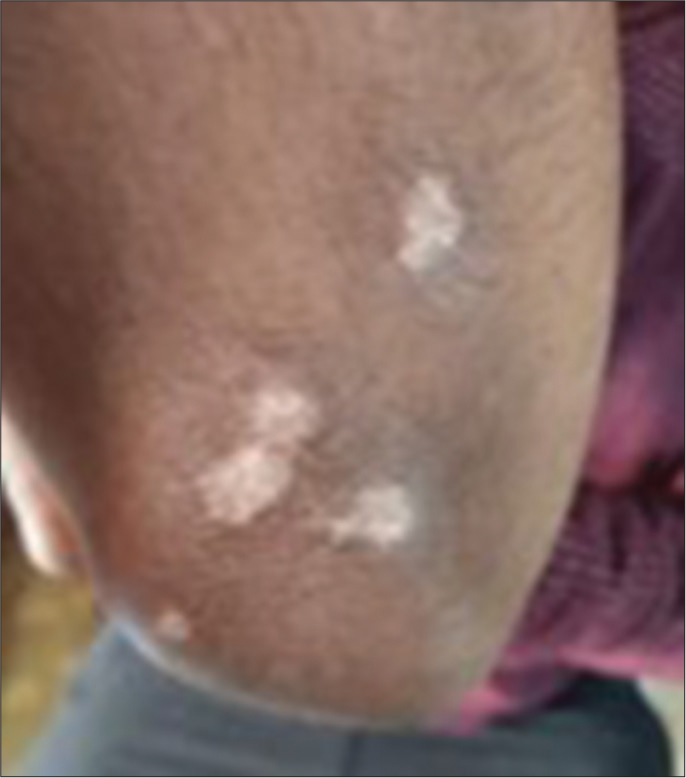
- Before treatment-case 5.
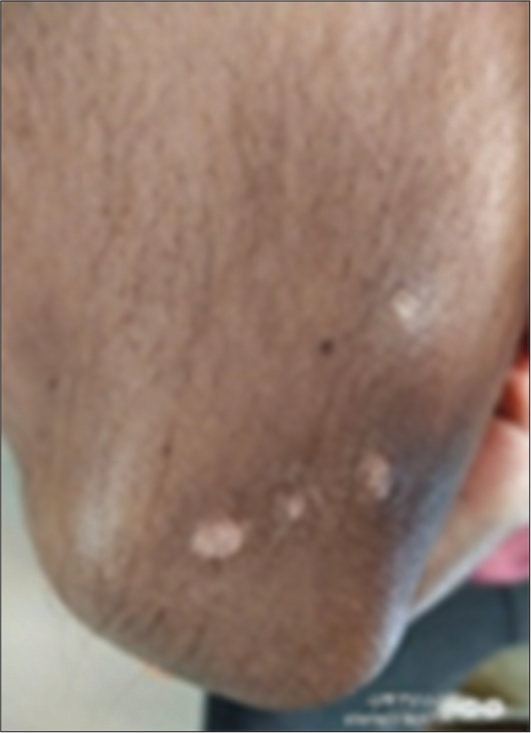
- Before treatment-case 5.
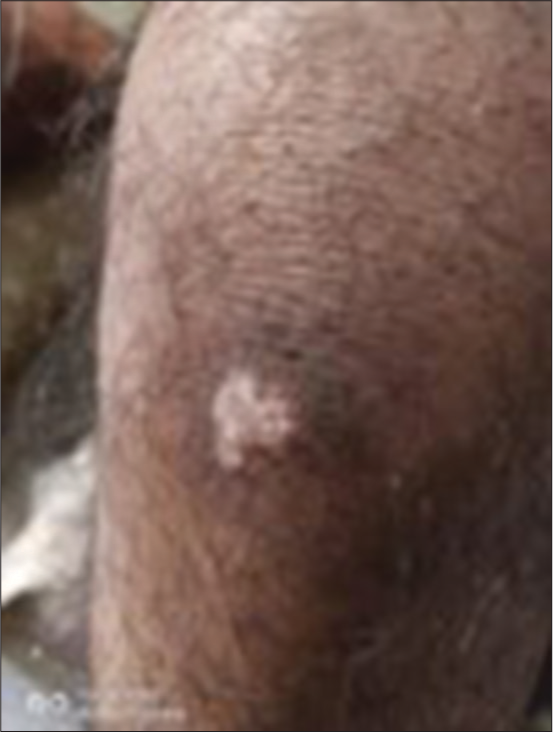
- Before treatment-case 5.
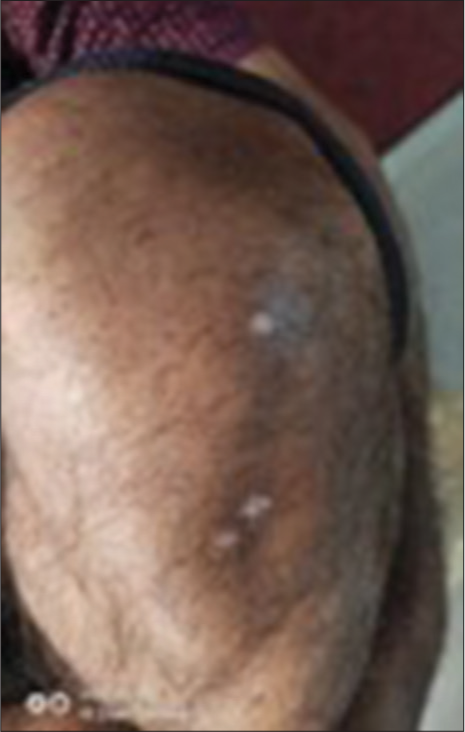
- Before treatment case 5.
After Treatment: [Figures 31-33].
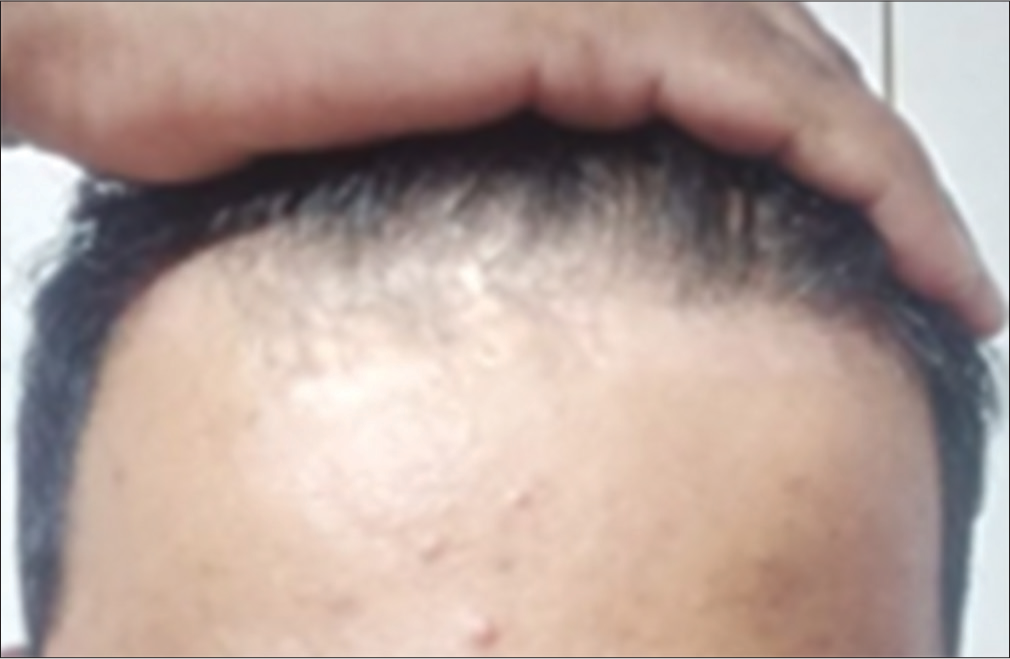
- After treatment-case 5.

- After treatment-case 5.
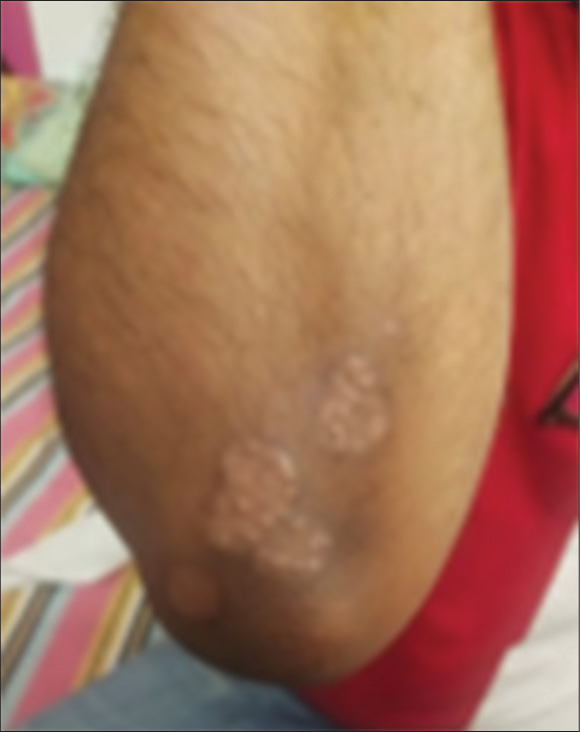
- After treatment-case 5.
Case 6
Presenting history
A 52-year-old male came with psoriatic lesions of 8 months duration for homoeopathic consultation. The lesions began on the right palm, followed by the left palm, right foot and then left foot. He had hyperpigmented indurated lesions with deep, painful, bleeding, dry cracks with raw skin areas. The toenails also have been affected. The palmar lesions responded well to allopathic treatment, after which foot patches developed. The foot lesions did not respond to allopathic treatment. He cannot tolerate hunger. He has profuse, offensive sweat on his feet. He cannot tolerate the heat of the sun. He craves sweets, non-veg and spicy food. He is thermally chilly. He is a casual drinker. He had a history of fungal infection in the past, for which he took allopathic treatment. He is very sensitive to people’s opinions about him. He keeps thinking about them. He is a very hard-working, responsible person. He cannot deny anyone anything and cannot confront anyone. He even used to hide his lesions to avoid people talking about it. His baseline PASI score was eight, and his DLQI score was 22.
Homoeopathic intervention
| Date | Symptoms | Prescription |
|---|---|---|
| 23.6.2021 | Pain in cracks, burning <touch, <walking, <cold water, <evening, <First motion Deep cracks to prevent infection |
Rhus tox 200 One dose OD for two weeks Calendula Q 10 drops in half cup water OD daily |
| 15.11.2021 | No improvement | Petroleum 200 One dose OD for a week Calendula Q 10 drops in half cup water OD daily |
| 7.12.2021 | No improvement Right-sided Cr- sweets, hot Chilly Scaling |
Calcarea carb 200 One dose OD for four days Chrysarobinum Q 10 drops in half cup of water daily |
| 24.2.2022 | Some aggravation followed by amelioration of skin symptoms. Little improvement was seen. skin A/F suppressed fungal infection |
Sulphur 30 Three doses Calcarea carb 200 once a week for one month |
| 23.6.2023 | Asymptomatic to date. No new symptoms |
No intervention |
Outcome
At the end of 2 years, the PASI score was O and the DLQI score was 0.
Before Treatment: [Figures 34-36].

- Before treatment-case 6.
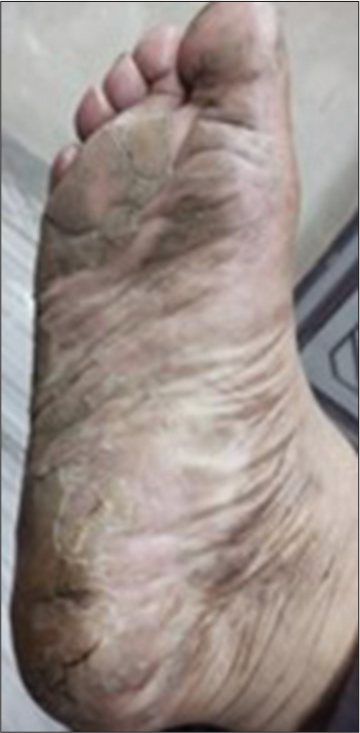
- Before treatment-case 6.

- Before treatment-case 6.
After Treatment: [Figure 37].
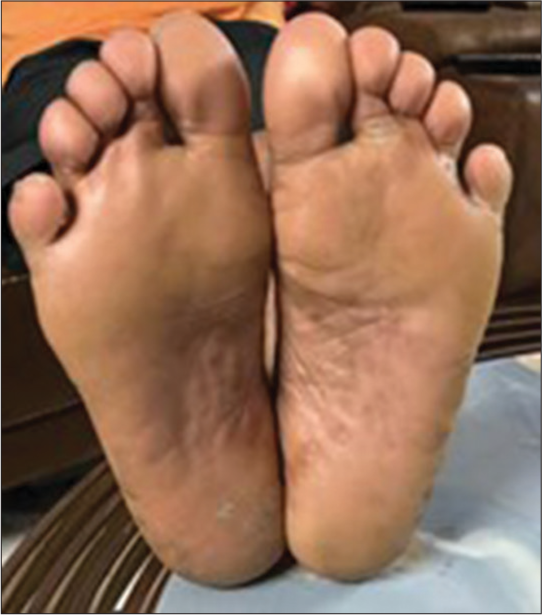
- After treatment-case 6.
MONARCH ASSESSMENT CRITERIA
| Case 1 | Case 2 | Case 3 | Case 4 | Case 5 | Case 6 | ||
|---|---|---|---|---|---|---|---|
| 1. | Was there an improvement in the main symptom for which Homoeopathy was prescribed? | Yes+2 | Yes+2 | Yes+2 | Yes+2 | Yes+2 | Yes+2 |
| 2. | Did the clinical improvement occur within a plausible time frame relative to the drug intake? | Yes+2 | Yes+2 | Yes+2 | Yes+2 | Yes+2 | Yes+2 |
| 3. | Was there an initial aggravation of symptoms? | No | No | No | No | No | No |
| 4. | Did the effect encompass more than the main symptom or condition? | No | No | No | Yes+2 | Yes+2 | No |
| 5. | Did overall wellbeing improve? | Yes | Yes | Yes | Yes | Yes | Yes |
| 6A. | Direction of cure-did some symptoms improve in the opposite order of development of symptoms of the disease? | No | No | No | No | No | No |
| 6B. | Direction of cure - From more important t less important organs - From deeper to superficial organs - From above downward |
Yes | Yes | Yes | Yes | Yes | Yes |
| 7. | Did old symptoms reappear temporarily during the course of treatment? | No | No | No | No | No | No |
| 8. | Are there alternate causes that, with a high probability, could have caused the improvement? | No | No | No | No | No | No |
| 9. | Was the health improvement confirmed by any objective evidence? | Yes | Yes | Yes | Yes | Yes | Yes |
| 10. | Did repeat dosing, if conducted, create similar clinical improvement? | Yes+2 | No | No | Yes+2 | Yes+2 | No |
DISCUSSION
In the cases, phase remedy, constitutional remedy, intercurrent remedy and mother tincture have been used together. Sometimes, we do not get the exact portrait of any remedy in the patient, or sometimes, the constitutional remedy is not clear. It takes 2–3 follow-ups to understand the simillimum. If the patients do not get the much-needed benefit within two months of homoeopathic treatment, they tend to choose alternative treatments, wherein they would have to face the side effects or give up and suffer lifelong.
There is no single cause/factor responsible for any natural disease. It is either a cause-effect or an action-result complex. We always look for the matrix of causes for any disease, and thus also for the medicines, we can safely say that this group of 3–4 medicines has helped the patient.
Science and research are exploratory and demand flexibility of thought. It is said in our texts that using the wrong remedies or multiple remedies may cause suppression. This study proves that a symptomatic combination of medicines helps the individual to recover naturally without any sign of suppression or adverse effects.
These cases are an experiment on a very small scale. Extending this to a large group of patients is needed for further clarity.
The action of the phasic remedies is limited to the acute symptoms and is short-acting. Hence, demands frequent repetition to ward off the acute exacerbation.
The constitutional remedy has a deeper and longer action. It acts on the psychosomatic plane and needs time to act, thus needing moderate repetition.
Intercurrent remedy aids in annihilating the miasmatic block, with a much deeper and longer action demands infrequent repetition.
Mother tincture acts purely based on the physiological action, being very short acting, it needs frequent repetition.
In this case series, 6 cases are presented. In the first two cases, as the symptoms were severe, a phasic remedy along with the constitutional and intercurrent remedies was prescribed. The patient responded well to this approach. In the third case, in addition to the above approach, a mother tincture was used to relieve symptoms at the physiological level. In the fourth case, as the disease was not active, only a constitutional remedy was prescribed, to which she responded very well. In the fifth case, as the disease was active, a phasic remedy, and a mother tincture, were used to relieve the acute distress, along with the constitutional and intercurrent remedies to prevent the recurrence. The patient responded well to this approach. In the sixth case, phasic remedy, mother tincture helped to relieve the acute distress along with the constitutional and the intercurrent remedies, which helped to prevent the recurrence of symptoms. This approach helped to palliate the acute disease activity as well as control the disease process. All the patients showed improvement within 1-2 months of starting the Homoeopathic treatment.
Phasic remedy: In 4 out of 6 cases, a phasic remedy was prescribed to alleviate the distressing acute symptoms, out of which 3 cases needed Arsenicum Album.
Mother tincture: 5 out of 6 cases needed a mother tincture to alleviate the excessive scaling of the skin, out of which 4 patients needed Hydrocotyle and 1 patient was given Chrysarbonium.
Constitutional remedy: 5 out of 6 cases were given a constitutional remedy to curb the disease process, out of which 5 patients needed Natrum muriaticum and one patient needed Calcarea carb 200.
Intercurrent remedy: 4 out of 6 patients needed an intercurrent remedy, out of which Sulphur 200 helped all the 4 patients.
There is no single cause / factor responsible for any natural disease. It is either a cause- effect or an action- result complex. We always look for the matrix of causes for any disease, and thus also for the medicines, we can safely say that this group of 3-4 medicines has helped the patient.
Science and research are exploratory and demand flexibility of thought. This study proves that symptomatic combination of medicines helps individual to recover naturally without any sign of suppression or adverse effects. This study presents an experiment conducted on 6 cases at a very small scale. Extending this design to a larger group of patients is needed for further clarity.
This study shows that the action of the phasic remedies is limited to the acute symptoms and is short acting. Hence, demands frequent repetition to ward off the acute exacerbation.
The Constitutional remedy has a deeper and a longer action. It acts on the psychosomatic plane and needs time to act, thus needing a moderate repetition.
Intercurrent remedy aids in annihilating the miasmatic block, with a much deeper and longer action demands infrequent repetition.
Mother tincture acts purely based on the physiological action, being very short acting, it needs frequent repetition.
As the said remedies work at different planes, they help recovery of the acute exacerbation, help remove the tendency and curb the disease process, thus relieving the patients for a longer duration of time.
Psoriasis is an autoimmune disease and is incurable. Our’s is more of a palliative role. The main aim of treating psoriasis is to alleviate the acute exacerbation and to give longer asymptomatic periods thus improving their quality of life. In the 6 cases studied, the patients are happy with the treatment, and they have an improved quality of life.
Limitations of the study
This approach used is not in accordance with classical Homoeopathy, but this study shows that using such an integrated approach with multiple indicated remedies in psoriasis helps in the management of psoriasis.
CONCLUSION
An integrated approach of intercurrent, constitutional remedies as a curative modality, and phasic remedy and mother tincture as a palliative modality has helped to achieve the goals of improvement in PASI and DLQI scores without any side effects. More clinical trials must be taken up to prove the efficacy of such an integrated approach in psoriasis.
Ethical approval
The Institutional Review Board approval is not required.
Declaration of patient consent
The authors certify that they have obtained all appropriate patient consent.
Conflicts of interest
There are no conflicts of interest.
Use of artificial intelligence (AI)-assisted technology for manuscript preparation
The author confirms that there was no use of artificial intelligence (AI)-assisted technology for assisting in the writing or editing of the manuscript and no images were manipulated using AI.
Financial support and sponsorship
Nil.
References
- Undertreatment, treatment trends, and treatment dissatisfaction among patients with psoriasis and psoriatic arthritis in the United States findings from the National Psoriasis Foundation surveys Germany: Research Gate; 2001. p. :2011.
- [Google Scholar]
- An evolution in switching therapy for psoriasis patients who fail to meet treatment goals. Dermatol Ther. 2015;28:390-403.
- [CrossRef] [PubMed] [Google Scholar]
- Plaque psoriasis successfully treated with individualized homoeopathic medicine Lycopodium: A case report. Homoeopath Links; 2020
- [CrossRef] [Google Scholar]
- Homoeopathy in plantar psoriasis: An evidence-based case report. Indian J Res Homoeopathy. 2022;16
- [CrossRef] [Google Scholar]
- Study of efficacy of homoeopathic medicines in management of plantar psoriasis treated after 2018: A retrospective study. Mater Novum J Homoeopathy. 2022;4:37-46.
- [Google Scholar]
- Evidence-based treatment of severe psoriasis by individualised homoeopathy: Case reports. Homœopath Links. 2022;35:164-74.
- [CrossRef] [Google Scholar]
- Organon of medicine (6th ed). Noida, Uttar Pradesh: B Jain Publishers (P) Ltd; 2018.
- [Google Scholar]
- Homoeopathy: Treatment of cancers with Banerjee protocols London: Intechopen; 2013. p. :130-42.
- [Google Scholar]
- Strategies for improving the quality of care in psoriasis with the use of treatment goals-a report on an implementation meeting. J Eur Acad Dermatol Venereol. 2011;25:1-13.
- [CrossRef] [PubMed] [Google Scholar]
- Evaluation of the modified Naranjo criteria for assessing causal attribution of clinical outcome to homeopathic intervention as presented in case reports. Homeopathy. 2020;109:191-7.
- [Google Scholar]






